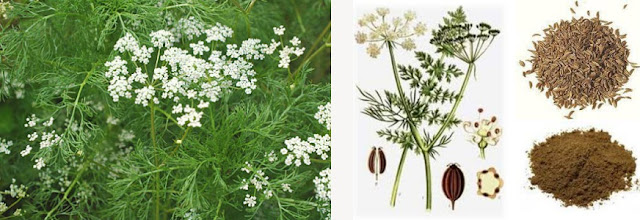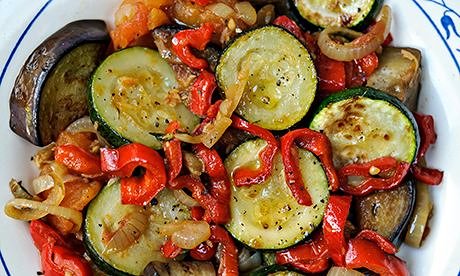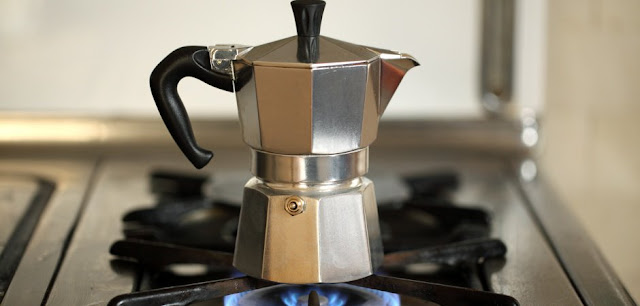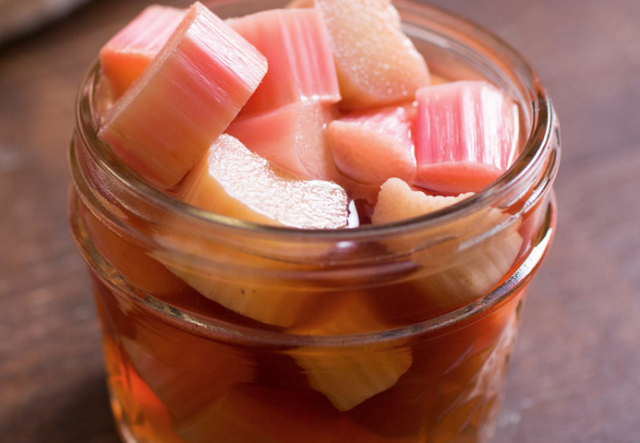The Apiaceae (Umbelliferae) are mostly temperate herbs almost always with umbellate inflorescences.
Foods in the Carrot Family – Including Parsley, Celery, and Caraway — Eat, don't eat
Many species of the Apiaceae are widely used vegetables, including:
parsley (Petroselinum crispum),
carrot (Daucus carota),
celery (Apium graveolens),
parsnip (Pastinaca sativa), and
fennel (Foeniculum vulgare).
Species used as herbs and spices include
anise (Pimpinella anisum),
dill (Anethum graveolens),
coriander (Coriandrum sativum),
caraway (Carum carvi),
cumin (Cuminum cyminum).
So, Cumin herb (Cuminum cyminum) and Caraway plant (Carum carvi) both a member of the parsley, carrot family, the family Apiaceae or Umbelliferae.
Besides looks, however, they do not have much else in common.
One wacky fact about Caraway Seed is that it not only resembles Cumin Seed but is often mistaken for Cumin in Indian recipes due to the translation of the name.
Only in the Northern area of India is Caraway alone used.
Another mistranslation comes from Turkish recipes calling for “black caraway” which is actually referring to Nigella Seed.
- Cumin seeds is the dried seed of the herb Cuminum cyminum, a member of the parsley family, the family Apiaceae or Umbelliferae.
It is an annual herbaceous plant, the plant has a uniform canopy.
Cumin seeds have eight ridges with oil canals.

- Caraway fruits (erroneously called seeds) is the dried seed of the Caraway plant (Carum carvi), a member of the family Apiaceae or Umbelliferae commonly known as the celery, carrot or parsley family, are a family of mostly aromatic plants with hollow stems.
Also Known As:
- Meridian fennel
- Persian cumin
It is a biennial plant…however, a polyploid variant (with four haploid sets=4n) of this plant was found to be perennial.
The caraway plant resembles a carrot (carrot-like foliage) and sets seed in its second year.
Caraway fruits (erroneously called seeds) have five pale ridges.
The Caraway fruits, usually used whole, have a pungent, anise-like flavor…the flavors can include notes of citrus peel but more dominantly can contain a strong anise (black licorice) flavor.
In fact you could substitute anise seeds for caraway seeds if you didn't have any.
Caraway is used as a spice in breads, especially rye bread.
While it has such a unique flavor profile, Caraway Seed is a fairly friendly spice and mixes well with other spices such as Coriander, Garlic, Juniper, and Thyme.
A mixture of Caraway Seed with one of these other spices can pair nicely in dishes containing apples, onions, potatoes and root vegetables alike, as well as duck or goose meat also with pork and cabbage.
Caraway seed is also used in flavoring curries, sausages and even liqueurs.
British seed cake is traditionally made with caraway seeds, as is the flavored Scandinavian spirit aquavit.
They're sometimes used in pickling and brining as well.
The leaves of the caraway plant can be used as an herb, much like its relative, parsley.
In addition, the root of the caraway plant can be eaten — it's similar to a parsnip.
Alys Fowler: Caraway, plus harvesting rocket seed | Life and style | The Guardian

Spice Substitutions - alternate ingredients for cooking and baking
Cumin: caraway seeds (½ tsp ground caraway per tsp cumin)
Foods in the Carrot Family – Including Parsley, Celery, and Caraway — Eat, don't eat
Many species of the Apiaceae are widely used vegetables, including:
parsley (Petroselinum crispum),
carrot (Daucus carota),
celery (Apium graveolens),
parsnip (Pastinaca sativa), and
fennel (Foeniculum vulgare).
Species used as herbs and spices include
anise (Pimpinella anisum),
dill (Anethum graveolens),
coriander (Coriandrum sativum),
caraway (Carum carvi),
cumin (Cuminum cyminum).
So, Cumin herb (Cuminum cyminum) and Caraway plant (Carum carvi) both a member of the parsley, carrot family, the family Apiaceae or Umbelliferae.
Besides looks, however, they do not have much else in common.
One wacky fact about Caraway Seed is that it not only resembles Cumin Seed but is often mistaken for Cumin in Indian recipes due to the translation of the name.
Only in the Northern area of India is Caraway alone used.
Another mistranslation comes from Turkish recipes calling for “black caraway” which is actually referring to Nigella Seed.
- Cumin seeds is the dried seed of the herb Cuminum cyminum, a member of the parsley family, the family Apiaceae or Umbelliferae.
It is an annual herbaceous plant, the plant has a uniform canopy.
Cumin seeds have eight ridges with oil canals.

- Caraway fruits (erroneously called seeds) is the dried seed of the Caraway plant (Carum carvi), a member of the family Apiaceae or Umbelliferae commonly known as the celery, carrot or parsley family, are a family of mostly aromatic plants with hollow stems.
Also Known As:
- Meridian fennel
- Persian cumin
It is a biennial plant…however, a polyploid variant (with four haploid sets=4n) of this plant was found to be perennial.
The caraway plant resembles a carrot (carrot-like foliage) and sets seed in its second year.
Caraway fruits (erroneously called seeds) have five pale ridges.
The Caraway fruits, usually used whole, have a pungent, anise-like flavor…the flavors can include notes of citrus peel but more dominantly can contain a strong anise (black licorice) flavor.
In fact you could substitute anise seeds for caraway seeds if you didn't have any.
Caraway is used as a spice in breads, especially rye bread.
While it has such a unique flavor profile, Caraway Seed is a fairly friendly spice and mixes well with other spices such as Coriander, Garlic, Juniper, and Thyme.
A mixture of Caraway Seed with one of these other spices can pair nicely in dishes containing apples, onions, potatoes and root vegetables alike, as well as duck or goose meat also with pork and cabbage.
Caraway seed is also used in flavoring curries, sausages and even liqueurs.
British seed cake is traditionally made with caraway seeds, as is the flavored Scandinavian spirit aquavit.
They're sometimes used in pickling and brining as well.
The leaves of the caraway plant can be used as an herb, much like its relative, parsley.
In addition, the root of the caraway plant can be eaten — it's similar to a parsnip.
Alys Fowler: Caraway, plus harvesting rocket seed | Life and style | The Guardian

Spice Substitutions - alternate ingredients for cooking and baking
Cumin: caraway seeds (½ tsp ground caraway per tsp cumin)









